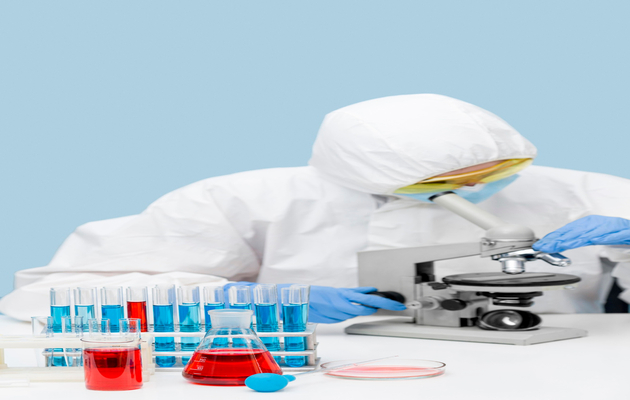What is Staining?
- It is a technique used in microscopy to enhance contrast in the microscopic image. Stains and dyes are frequently used to highlight structures in biological tissues for viewing, often with the aid of different microscopes.
- It is the process of colouring colourless bacterial structural components using stains (dyes). The principle of staining is to identify microorganisms selectively by using dyes, fluorescence and radioisotope emission.
- Staining reactions are made possible because of the physical phenomena of capillary osmosis, solubility, adsorption, and absorption of stains or dyes by cells of microorganisms.
Individual variation in the cell wall constituents among different groups of bacteria will consequently produce variations in colours during microscopic examination.

Objectives of Staining
- Improves visibility by greater contrast between the organism and the background.
- Differentiate various morphological types (by shape, size, arrangement, etc).
- Determine the staining characteristic of the organism and, at times, direct diagnosis of disease.
- Demonstrate the purity of culture.
- Observe certain structures (flagella, capsules, endospores, etc).
General methods of staining
1. Direct staining: It is the process by which microorganisms are stained with simple dyes. E.g., methylene blue.
2. Indirect staining: It is the process which needs mordants. A mordant is a substance that, when taken up by the microbial cells helps make dye in return, serving as a link or bridge to make the staining recline possible.
It combines with a dye to form a coloured “lake”, which in turn combines with the microbial cell to form a “cell-mordant-dye complex”.
It is an integral part of the staining reaction itself, without which no staining could occur. E.g., iodine.
A mordant may be applied before the stain or it may be included as part of the staining technique or it may be added to the dye solution itself.
3.Progressive staining: It is the process whereby microbial cells are stained in a definite sequence, so that a satisfactory differential coloration of the cell may be achieved at the end of the correct time with the staining solution.
4.Regressive staining:
– with this technique, the microbial cell is first over-stained to obliterate the cellular desires, and the excess stain is removed or decolourized from unwanted parts.
5.Differentiation (decolourization)
– is the selective removal of excess stain from the tissue from microbial cells during regressive staining so that a specific substance may be stained differentially from the surrounding cell.
Uses:
- To observe the morphology, size, and arrangement of bacteria.
- To differentiate one group of bacteria from the other group. Biological stains are dyes used to stain microorganisms.
Types of staining methods
- Simple method
- Differential method
1. Simple staining method
- In this method only a single dye is used. It uses only a single dye that does not differentiate between different types of organisms.
- There is only a single staining step and everything is stained with the same color.
- Simple stains are used to stain whole cells or to stain specific cellular components.
Types of simple method:
a. Direct / Positive: stain object
b. Indirect / Negative: stain background
a. Positive staining
- A simple technique that stains the bacterial cells in a single colour.
- Many of the bacterial stains are basic chemicals; these basic dyes react with negatively charged bacterial cytoplasm (opposite charges attract) and the organism becomes directly stained
- Examples are methylene blue, crystal violet, and basic fuchsin.
Procedure:
- Make a smear and label it.
- Allow the smear to dry in the air.
- Fix the smear over a flame.
- Apply a few drops of positive simple stain like 1% methylene blue, 1% carbol fuchsin or 1% gentian violet for 1 minute.
- Wash off the stain with water.
- Air-dry and examine under the oil immersion objective.
b. Negative staining
- In this process, instead of cells background is stained.
- The dye stains the background and the bacteria remain unstained. E.g., Indian ink stain Negrosin stain
2. Differential method
Multiple stains are used in a differential method to distinguish different cell structures and/or cell types. E.g., Gram stain and Ziehl-Neelson stain.
Stains and dyes
- A dye is a general-purpose colouring agent, whereas a stain is used for colouring biological material.
- A stain is an organic compound containing a benzene ring plus a chromophore and an auxochrome group.
- Chromophore is a chemical group that imparts colour to benzene.
- The auxochrome group is a chemical compound that conveys the property of ionization of chromogen (ability to form salts) and bind to fibres or tissues.
Why are stains not taken up by every microorganism? Factors controlling the selectivity of microbial cells are:
- Number and affinity of binding sites
- Rate of reagent uptake
- Rate of reaction
- Rate of reagent loss
Why do dyes colour microbial cells? Because dyes absorb radiation energy in the visible region of the electromagnetic spectrum i.e., “light” (wavelength 400-650). And absorption is anything outside this range it is colourless. E.g., acid fuschin absorbs blue-green and transmits red.
Types of microbiological stains
- Basic stains
- Acidic stains
- Neutral stains
- Basic stains are stains in which the colouring substance is contained in the base part of the stain. The acidic part is colourless. Basic stains include methylene blue, crystal violet, malachite green, basic fuchsin, carbol fuchsin, and safranin.
- Acidic stains are stains in which the colouring substance is contained in the acidic part of the stain. Acidic stains include eosin, acid fuchsin, rose bengal, and congo red.
- Neutral stains are stains in which the acidic and basic components of the stain are coloured. Neutral dyes stain both nucleic acid and cytoplasm. Neutral stains include Giemsa’s, Jenner’s, Leishman’s, and Wright’s stains.
References
- https://microbenotes.com/?s=staining+technique
- https://microbeonline.com/?s=staining+technique
- https://bio.libretexts.org/Courses/North_Carolina_State_University/MB352_General_Microbiology_Laboratory_2021
- https://www.toppr.com/
- https://study.com/
- https://www.sciencedirect.com
- https://www.bionity.com

2 thoughts on “Staining: Objectives, Types and Techniques”